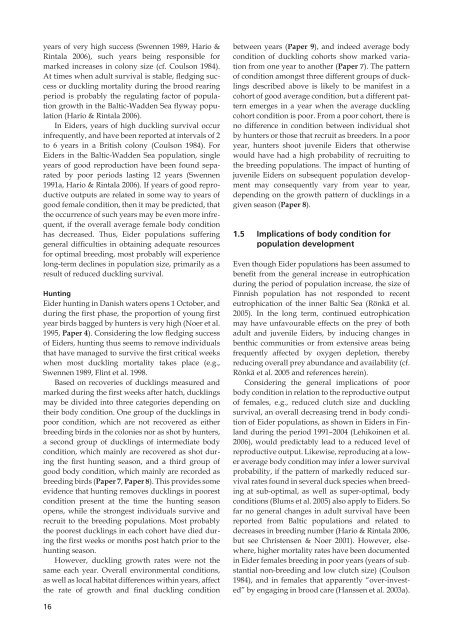Factors affecting population size of Baltic Common Eiders Somateria ...
Factors affecting population size of Baltic Common Eiders Somateria ...
Factors affecting population size of Baltic Common Eiders Somateria ...
You also want an ePaper? Increase the reach of your titles
YUMPU automatically turns print PDFs into web optimized ePapers that Google loves.
years <strong>of</strong> very high success (Swennen 1989, Hario &<br />
Rintala 2006), such years being responsible for<br />
marked increases in colony <strong>size</strong> (cf. Coulson 1984).<br />
At times when adult survival is stable, fledging success<br />
or duckling mortality during the brood rearing<br />
period is probably the regulating factor <strong>of</strong> <strong>population</strong><br />
growth in the <strong>Baltic</strong>-Wadden Sea flyway <strong>population</strong><br />
(Hario & Rintala 2006).<br />
In <strong>Eiders</strong>, years <strong>of</strong> high duckling survival occur<br />
infrequently, and have been reported at intervals <strong>of</strong> 2<br />
to 6 years in a British colony (Coulson 1984). For<br />
<strong>Eiders</strong> in the <strong>Baltic</strong>-Wadden Sea <strong>population</strong>, single<br />
years <strong>of</strong> good reproduction have been found separated<br />
by poor periods lasting 12 years (Swennen<br />
1991a, Hario & Rintala 2006). If years <strong>of</strong> good reproductive<br />
outputs are related in some way to years <strong>of</strong><br />
good female condition, then it may be predicted, that<br />
the occurrence <strong>of</strong> such years may be even more infrequent,<br />
if the overall average female body condition<br />
has decreased. Thus, Eider <strong>population</strong>s suffering<br />
general difficulties in obtaining adequate resources<br />
for optimal breeding, most probably will experience<br />
long-term declines in <strong>population</strong> <strong>size</strong>, primarily as a<br />
result <strong>of</strong> reduced duckling survival.<br />
Hunting<br />
Eider hunting in Danish waters opens 1 October, and<br />
during the first phase, the proportion <strong>of</strong> young first<br />
year birds bagged by hunters is very high (Noer et al.<br />
1995, Paper 4). Considering the low fledging success<br />
<strong>of</strong> <strong>Eiders</strong>, hunting thus seems to remove individuals<br />
that have managed to survive the first critical weeks<br />
when most duckling mortality takes place (e.g.,<br />
Swennen 1989, Flint et al. 1998.<br />
Based on recoveries <strong>of</strong> ducklings measured and<br />
marked during the first weeks after hatch, ducklings<br />
may be divided into three categories depending on<br />
their body condition. One group <strong>of</strong> the ducklings in<br />
poor condition, which are not recovered as either<br />
breeding birds in the colonies nor as shot by hunters,<br />
a second group <strong>of</strong> ducklings <strong>of</strong> intermediate body<br />
condition, which mainly are recovered as shot during<br />
the first hunting season, and a third group <strong>of</strong><br />
good body condition, which mainly are recorded as<br />
breeding birds (Paper 7, Paper 8). This provides some<br />
evidence that hunting removes ducklings in poorest<br />
condition present at the time the hunting season<br />
opens, while the strongest individuals survive and<br />
recruit to the breeding <strong>population</strong>s. Most probably<br />
the poorest ducklings in each cohort have died during<br />
the first weeks or months post hatch prior to the<br />
hunting season.<br />
However, duckling growth rates were not the<br />
same each year. Overall environmental conditions,<br />
as well as local habitat differences within years, affect<br />
the rate <strong>of</strong> growth and final duckling condition<br />
16<br />
between years (Paper 9), and indeed average body<br />
condition <strong>of</strong> duckling cohorts show marked variation<br />
from one year to another (Paper 7). The pattern<br />
<strong>of</strong> condition amongst three different groups <strong>of</strong> ducklings<br />
described above is likely to be manifest in a<br />
cohort <strong>of</strong> good average condition, but a different pattern<br />
emerges in a year when the average duckling<br />
cohort condition is poor. From a poor cohort, there is<br />
no difference in condition between individual shot<br />
by hunters or those that recruit as breeders. In a poor<br />
year, hunters shoot juvenile <strong>Eiders</strong> that otherwise<br />
would have had a high probability <strong>of</strong> recruiting to<br />
the breeding <strong>population</strong>s. The impact <strong>of</strong> hunting <strong>of</strong><br />
juvenile <strong>Eiders</strong> on subsequent <strong>population</strong> development<br />
may consequently vary from year to year,<br />
depending on the growth pattern <strong>of</strong> ducklings in a<br />
given season (Paper 8).<br />
1.5 Implications <strong>of</strong> body condition for<br />
<strong>population</strong> development<br />
Even though Eider <strong>population</strong>s has been assumed to<br />
benefit from the general increase in eutrophication<br />
during the period <strong>of</strong> <strong>population</strong> increase, the <strong>size</strong> <strong>of</strong><br />
Finnish <strong>population</strong> has not responded to recent<br />
eutrophication <strong>of</strong> the inner <strong>Baltic</strong> Sea (Rönkä et al.<br />
2005). In the long term, continued eutrophication<br />
may have unfavourable effects on the prey <strong>of</strong> both<br />
adult and juvenile <strong>Eiders</strong>, by inducing changes in<br />
benthic communities or from extensive areas being<br />
frequently affected by oxygen depletion, thereby<br />
reducing overall prey abundance and availability (cf.<br />
Rönkä et al. 2005 and references herein).<br />
Considering the general implications <strong>of</strong> poor<br />
body condition in relation to the reproductive output<br />
<strong>of</strong> females, e.g., reduced clutch <strong>size</strong> and duckling<br />
survival, an overall decreasing trend in body condition<br />
<strong>of</strong> Eider <strong>population</strong>s, as shown in <strong>Eiders</strong> in Finland<br />
during the period 1991–2004 (Lehikoinen et al.<br />
2006), would predictably lead to a reduced level <strong>of</strong><br />
reproductive output. Likewise, reproducing at a lower<br />
average body condition may infer a lower survival<br />
probability, if the pattern <strong>of</strong> markedly reduced survival<br />
rates found in several duck species when breeding<br />
at sub-optimal, as well as super-optimal, body<br />
conditions (Blums et al. 2005) also apply to <strong>Eiders</strong>. So<br />
far no general changes in adult survival have been<br />
reported from <strong>Baltic</strong> <strong>population</strong>s and related to<br />
decreases in breeding number (Hario & Rintala 2006,<br />
but see Christensen & Noer 2001). However, elsewhere,<br />
higher mortality rates have been documented<br />
in Eider females breeding in poor years (years <strong>of</strong> substantial<br />
non-breeding and low clutch <strong>size</strong>) (Coulson<br />
1984), and in females that apparently “over-invested”<br />
by engaging in brood care (Hanssen et al. 2003a).

















